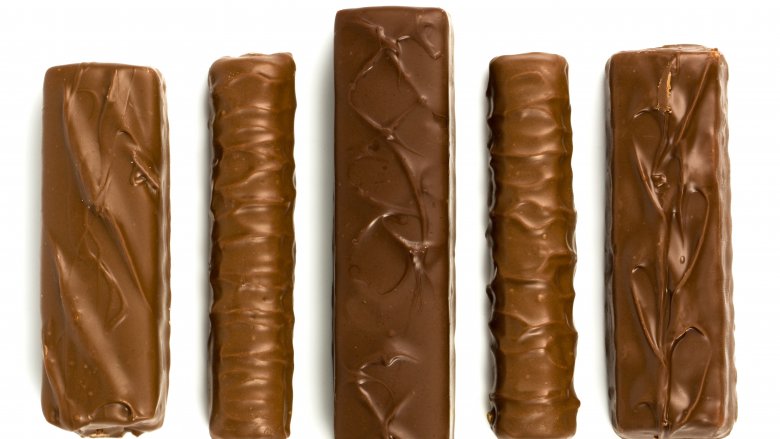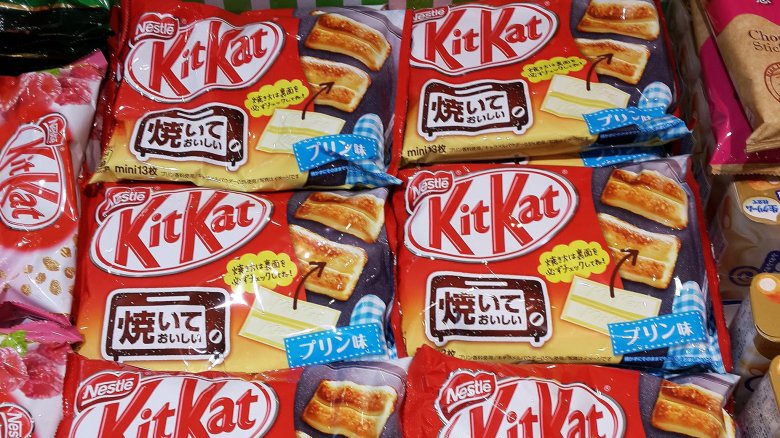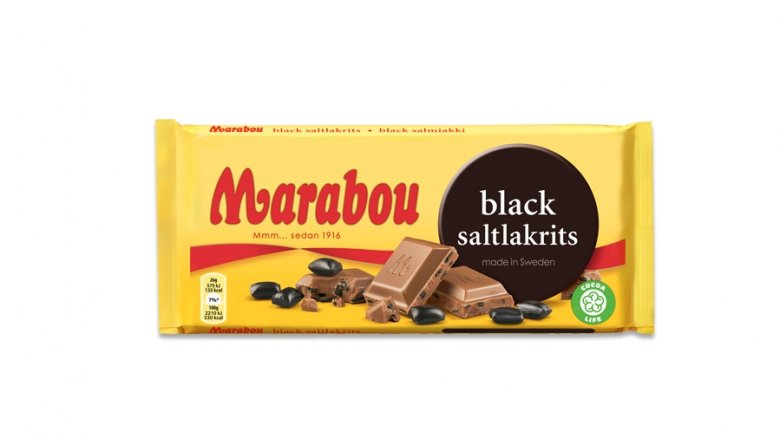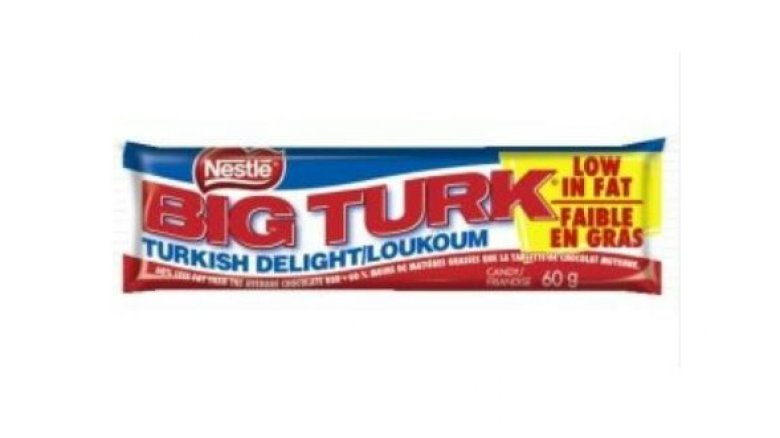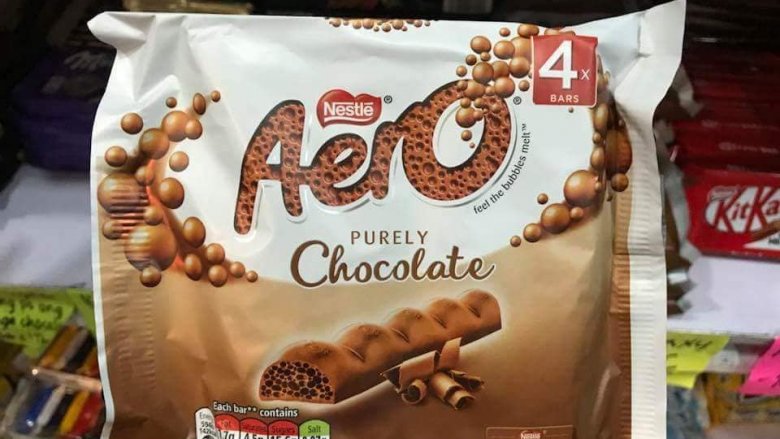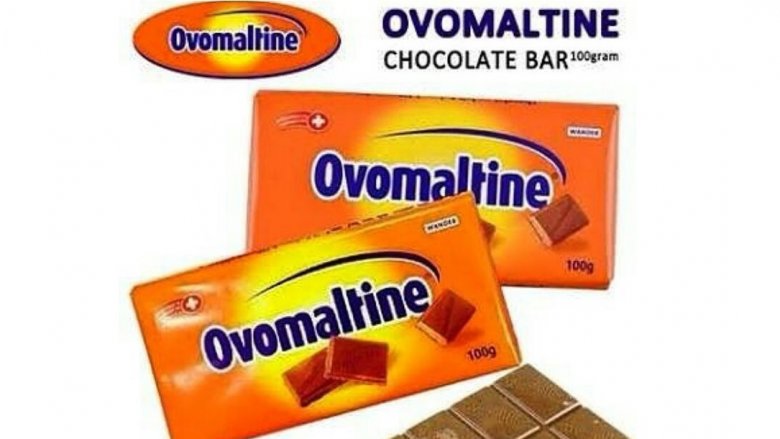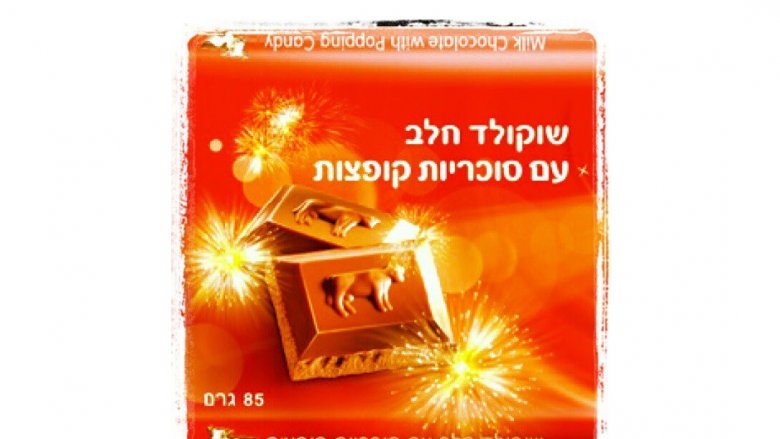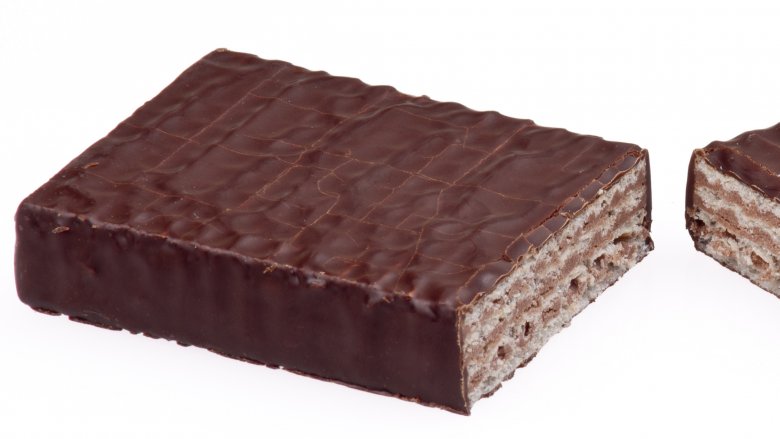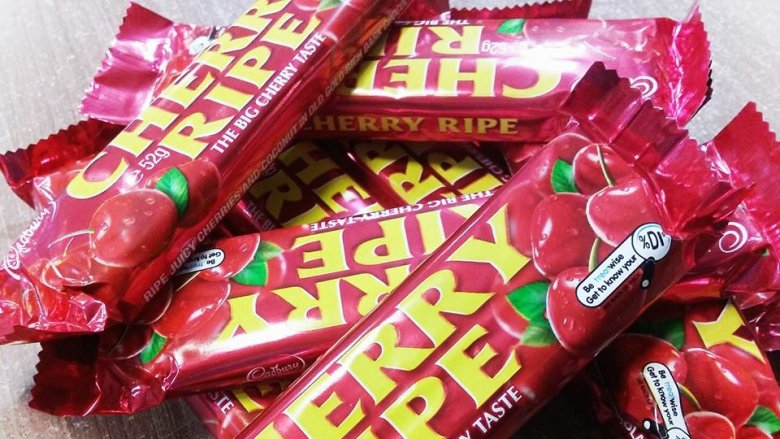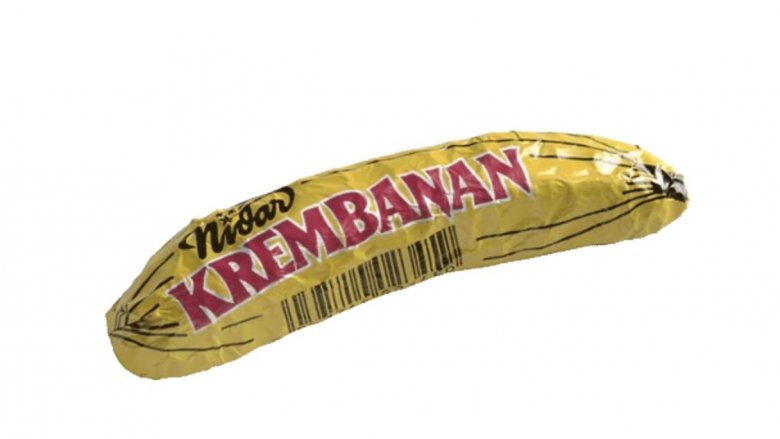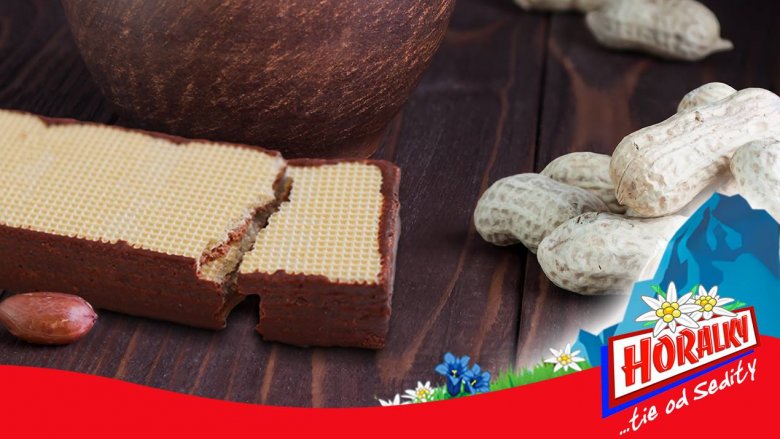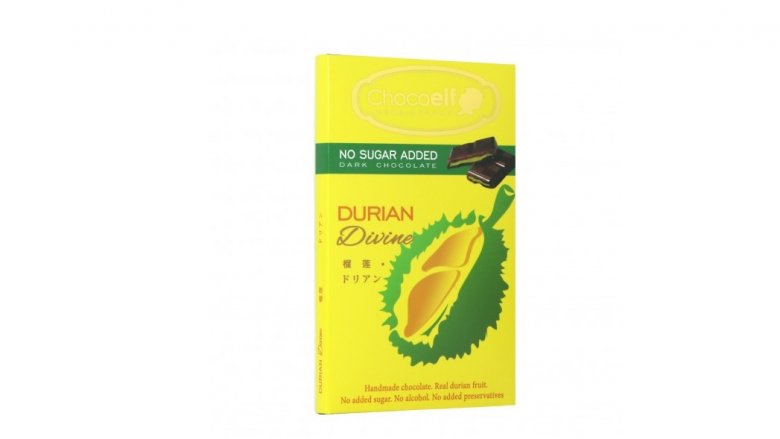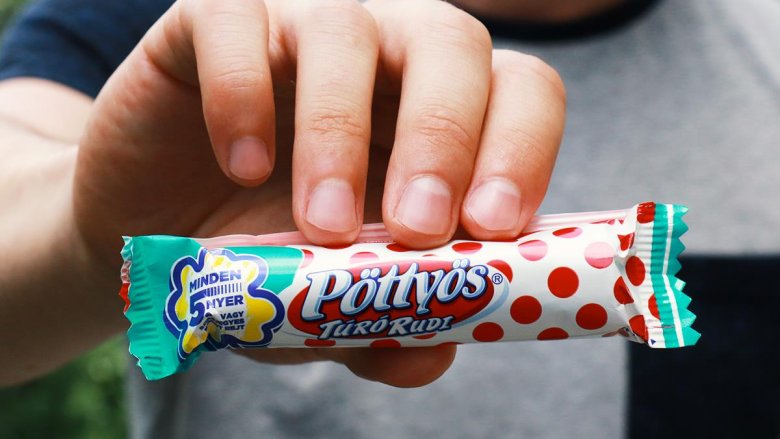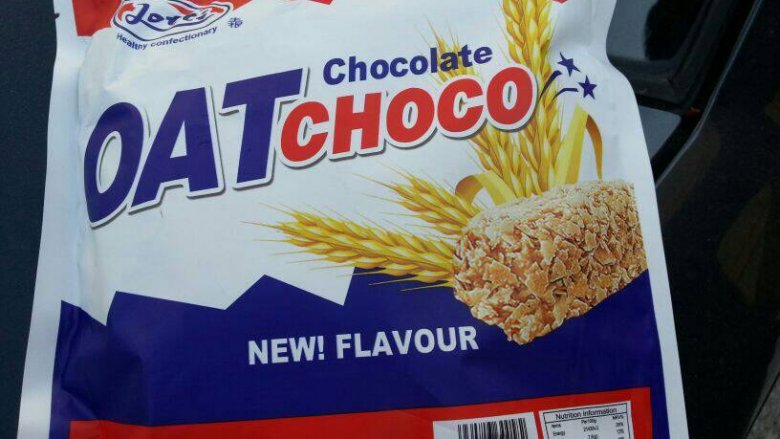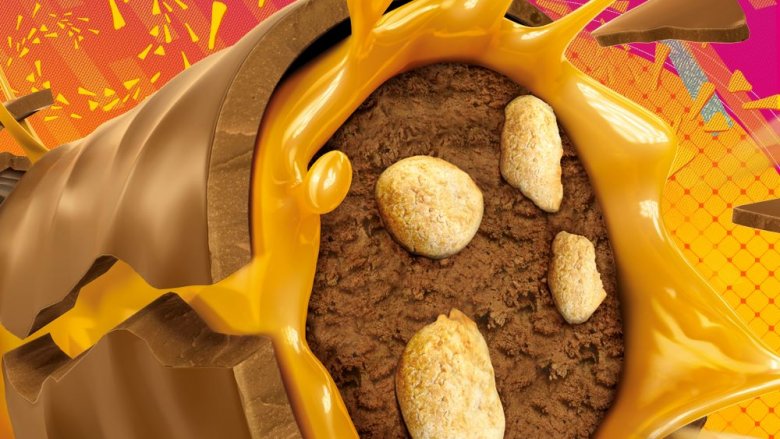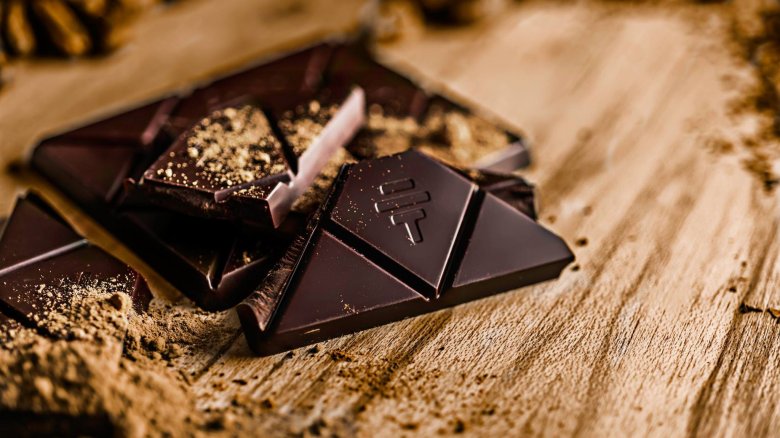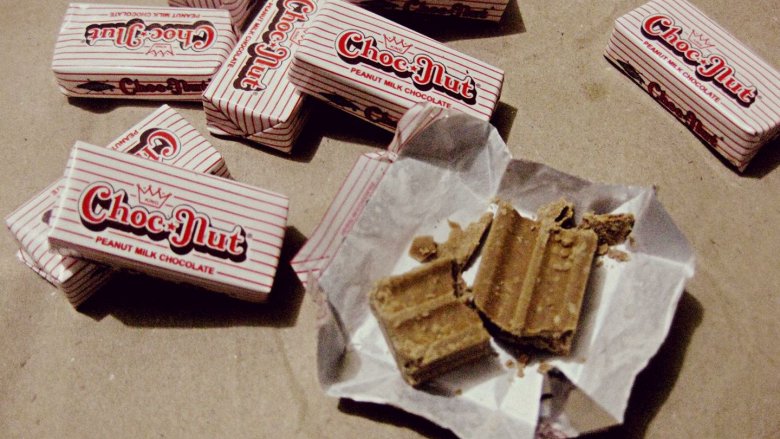Candy Bars You Can't Find In The US
We may receive a commission on purchases made from links.
It could take a lifetime — a delicious, albeit dental work-fraught, one at that — to try and taste every single one of the colorful candy bars available for purchase in the United States. After polishing off your standard Snickers, Twix, and Hershey's bars and their many mouth-watering varieties, there are still regional favorites like Florida's Coconut Patties and Idaho's Idaho Spuds.
But domestic candy bars are just the beginning. The world is a big place, and it's full of tasty, creative, and downright unusual candy bars begging to be devoured. These rare, exotic treats won't be found at your local supermarket, convenience store, or office vending machine. The only way to experience them? Travel the world (or maybe try Amazon — but that takes all the fun out of it!).
If ever you need even more reason to travel abroad, here are some amazing candy bars you can't find in the US.
Bake 'N Tasty Mini Kit Kats
Japan is notoriously obsessed with Kit Kats, Nestlé's iconic chocolate bar with layers of wafers and chocolate. The country is home to high-end boutiques devoted to Kit Kats, which are available in a constantly changing array of flavors. Some of those flavors — such as the Edamame Soy Bean Kit Kat or the Hot Japanese Chili Kit Kat — sound iffy. But others, like the Bake 'N Tasty Mini Kit Kats, sound like pure candy genius.
Debuted in 2014, the Bake 'N Tasty set itself apart from all other Kit Kats by being bakeable. And baking isn't just allowed — it's suggested. To enjoy the Bake N' Tasty Mini Kit Kat as creator and renowned Japanese patissier Yasumasa Takagi intended, you heat it in a toaster oven so the sugar hardens. The sugar hardens faster than the chocolate, resulting in a puffed up, wafer biscuit with an irresistible caramel aroma.
When the Bake 'N Tasty Kit Kats were first released, they were available in original chocolate and custard pudding flavors. Since then, additional flavors like sweet potato, cheesecake, and ice cream, have been added to the line.
Marabou Black Saltakrits
The Swedish are serious when it comes to candy, averaging around 35 to 40 pounds of godis consumption per person each year. But from skumkantereller (mushroom-shaped marshmallows) to bilar (gummy cars), there is one Swedish candy that tops them all: salmiak, or salty black licorice
Just as Japan adores Kit Kats, the Swedes are borderline obsessed with black licorice. The distinctive, savory sweet is flavored with ammonium chloride, a salt alternative made from combining hydrochloric acid and ammonia. The salty compound is heated with dried licorice root extracts, sugar, starch, and wheat flour to produce salmiak. The unique candy has a powerful flavor that can cause a tongue-numbing sensation, along with anti-inflammatory and laxative properties.
In Sweden, entire stores are dedicated to licorice-related products, from lakrits fiskar (licorice fish) to licorice cold brew to Marabou Black Saltlakrits, a beloved Swedish candy bar. The treat is essentially a milk chocolate bar speckled with chucks of black licorice. Reviewers agree, if you love chocolate and you love black licorice, you'll love this bar. If you're not into chocolate and/or black licorice, you probably won't. If that's the case, the brand also sells candy bars with more "normal" fillings, like roasted hazelnuts and coconut toffee.
Big Turk
To understand the Big Turk candy bar, we must first understand Turkish Delight. A candy from Turkey that many know from reading or watching The Chronicles of Narnia, Turkish Delight is comprised of chewy, gelatinous cubes of starch and sugar, traditionally flavored with rosewater.
The Big Turk candy bar itself hails not from Turkey, but Canada. Manufactured by Nestlé Canada, the candy bar is essentially pink Turkish Delight coated in an ever-so-thin layer of chocolate. Because Turkish Delights are fat free, the Big Turk is quite a bit lower in fat compared to other candy bars — 60 percent lower, to be precise.
Before you embark on a quest to hunt down a Big Turk, a word of caution: you may have difficulty finding the Big Turk even if you cross the border into Canada. Bloggers report the candy bar isn't that popular among the Caramilk- and Smarties-loving Canadians, so you may have to do some rummaging around the bottom of the candy rack to dig up the illusive treat.
Aero
Another chocolate bar from the all-powerful candy giant Nestlé, Aero bars are scarfed down by chocolate lovers all over the world, including the UK, Canada, Australia, South Africa, and Japan. Tragically, ever since their unsuccessful American launch in the 1980s, Aero chocolate bars have become tough to find in the U.S. outside of Amazon.
Aero is named from it's aerated texture, allowing the chocolate to melt into your mouth effortlessly as the bubble walls collapse. The unique, bubbly chocolate was born in the UK back in 1935. Since discovering the magic behind the bubbly chocolate, the secret formula has been been closely guarded by Nestlé.
Since the release of the original Aero chocolate bar nearly a century ago, variations like Aero Bubbles, Mouse, White Chocolate Big Bubble Bar, Dark Chocolate Big Bubble Bar, and Dark Cherry Truffle Big Bubble Bar have been introduced. The bars made with sustainably sourced cocoa as part of the Nestlé Cocoa Plan, an initiative to improve the lives of cocoa farmers around the world.
Ovomaltine chocolate bars
Over in the land of Switzerland in a town called Ovomaltine, there lived a local pharmacist named Dr. Georg Wander with a dream. The time was 1865, and childhood mortality rate was high because of undernourishment. The pharmacist tried to develop a "power nutrition" out of a malt extract. After Wander died, his son Albert took over, adding nutritious ingredients like egg, milk, and cocoa to his father's concoction. Thus, in 1904, Ovomaltine powder — known as "Ovaltine" by English speakers — was born. The original powder was designed to be dissolved in milk.
Today, Ovomaltine has expanded beyond nutritional powder for beverages into a variety of products enjoyed internationally. In Switzerland and other European countries, you can buy Ovomaltine cereal, Ovomaltine spread, and Ovomaltine biscuits. You can even buy Ovomaltine chocolate bars made from the iconic malted milk powder and hazelnuts — if you're lucky enough to be candy-shopping in Europe, that is. Reviewers note that the candy bar smells like Ovomaltine powder and delivers more of a malty kick than a chocolate flavor.
Elite milk chocolate bar with popping candy
Israel's leading chocolate brand, Elite chocolates and candies are as ubiquitous in Israel as Hershey's is in the U.S. The candy company comes with a compelling history. Originally called "Laima" ("luck"), the sweet manufacturer was based in Latvia and relocated to Israel during the Nazi's rise to power in the early 1930s. Newly dubbed Elite, the brand supplied chocolate to the allied forces stationed near their Tel Aviv-based factory during World War II.
The modern-day Elite churns out a variety of certified Kosher chocolates, including Elite milk chocolate, white chocolate, and bittersweet chocolate bars. Then, there are bars with fun fillings, like strawberry cream, coconut, and nuts. But the funnest filling of all the Elite chocolate bars is arguably popping candy. The Elite milk chocolate bar with popping candy is perhaps best described as chocolate bars infused with Pop Rocks, which explode and tickle your tongue as you gobble it down.
Prince Polo
The Prince Polo chocolate bar surfaced in Poland while the country was still under communist government. In the 1950s, the candy spread to countries across Europe and eventually to Iceland, where it was a huge hit. Legend has it that the candy is so popular in Iceland, local newspaper Morgunblaðið once put out an issue with a front-page headline that read, "Prince Polo is sold out".
On the Nordic island nation, the average resident eats a half kilo (or more than a pound) of Prince Polo each year, according to stats from Icelandic newspaper Visir. This is down from 1970, when Icelanders reportedly consumed a full kilo of Prince Polo every year.
The reason behind Prince Polo's decline in Iceland may have been due to the rise in competition from other chocolate manufacturers when Iceland laxened import restrictions in 1982. But the reason(s) for its success is obvious: Dark chocolate. Four layers of crunchy wafers. Three layers of chocolatey cream filling. Pairs well with coffee.
Cherry Ripe
From the invention of the microwave to the extinction of the telephone operator, a lot has changed since 1924. But even as technology has transformed, new products flooded the marketplace, and the Spice Girls have risen and fallen, one Australian chocolate bar has managed to stick around.
Cherry Ripe, Australia's oldest chocolate bar, was first dreamed up by the chocolatiers at MacRobertson Chocolates in 1924. The company was bought by Cadbury in 1967, allowing love for Cherry Ripes to spread even farther.
Over the generations and change in ownership, the basic recipe for Cherry Ripe has stayed the same: a chocolate bar is filled with a spongy mix of coconut and cherries, coated in a layer of dark chocolate. The bar has managed to remain one of Australia's most popular chocolate bars, even as other gems like the Flake chocolate bar and Crunchie bar hit the Australian market.
Krembanan
A Krembanan ("cream banana") chocolate bar manages to excite the senses before you even open the wrapper. How? Because it's shaped like a banana and wrapped in banana-colored foil. Peel off the foil and take a bite, and the Krembanan delivers on the promise foretold by its shape and packaging: Beneath a layer of chocolate lies a filling of jelly and banana cream.
The magical chocolate bar is a product of Nidar, a Norwegian chocolate and candy manufacturer. Krembanan hasn't had a makeover or recipe update since it was introduced in 1957. In fact, the chocolate bars are still packaged by Nidar's original machine, which was designed especially to package curved, banana shapes, and is the oldest machine in use in the factory.
Krembanan's honest shape and wrapping make it among the few chocolates that taste like the thing they're supposed to look like. If you've ever bitten into a chocolate rabbit only to be disappointed to find it tastes nothing like rabbit, Krembanan may be the bar for you.
Horalky
Like many great inventions, Horalky candy bars were born out of necessity. It was 1965 in Slovakia, and there was a shortage of hazelnuts — a key ingredient in traditional wafers — so bakers swapped in peanuts. The popularity of these new, never- before-tried peanut wafers lead to the eventual creation of Horalky, a candy bar with layers of wafers and peanut cream beneath a thin chocolate coat.
Generations later, the Sedita bakery manufactures around 160 million Horalky bars each year. According to the time-honored recipe, crispy wafers are layered with roasted peanut cream filling and finished with a coat of chocolate. The peanuts are carried over to Slovakia all the way from South America, while the cocoa for the chocolate comes from Africa's Ivory Coast.
Horalky is famously beloved by Czech singer Karel Gott. "Sometimes I take Horalky for breakfast, because I really like them," the star told Horalky — probably to try and finagle some free Horalky bars.
Chocoelf Durian chocolate bar
Dubbed "the king of fruits" by fans, the durian is an offensive-smelling fruit beloved across Southeast Asia. The pungent fruit is massive, with a spiky shell and soft, yellow flesh. The taste is exotic but the scent is downright putrid, resulting in the fruit being banned on public transportation and hotels.
Despite the durian's overpowering odor, the fruit has earned cult status in many Southeast Asian countries, but arguably nowhere more so than Singapore. As homage to the king of fruits, the country has a erected a durian-shaped building and dreamed up many a durian fruit dish. So it comes as no surprise that Singapore would also produce a variety of durian candies.
One of our favorites is the durian dark chocolate bar from Chocoelf, a Singaporean chocolatier that focuses on low- or no-sugar chocolates. Without any additional sugar, the durian chocolate bar lets you enjoy (or suffer through) the intense flavor of durian.
Túró Rudi
Hailing from Hungary, the Túró Rudi chocolate bar originated as a homemade treat made from fresh túró, or cottage cheese. The mass-marketed version replaces cottage cheese with a sweetened dairy curd stick that looks kind of like cheesecake. The creamy filling is covered with a thin layer of chocolate. In addition to traditional Túró Rudi bars, there are also flavor varieties like peanut butter, strawberry, and apricot.
The Túró Rudi has been manufactured by a variety of companies over the last half century. The most widely recognized is the Pöttyös (spotted) brand, which features a white rapper with red polka dots.
Unlike many of the bars on this list, the Túró Rudi is hard to find — even on the all-mighty Amazon — because it requires refrigeration. If you want to give it a try, you may have to plan a vacation to the dairy aisle of a grocery store in Hungary. While you're there, we suggest picking up some Körözött cheese spread.
Chocolate Oat Choco
Among the many singular, fascinating, and sometimes confusing things about China is its ambivalent attitude towards chocolate. As one study noted, the Chinese consume a mere 100 grams of chocolate (around two bars) each year compared to the 90 bars each consumed in many European countries. Noble attempts to infect China with chocolate fever began in the in 1970s, when Hershey, Nestlé, and other members of the world's chocolate giants entered the market. But decades later, chocolate still hasn't took off in the awakening giant.
How can so many of China's more than one billion residents still wave away chocolate bars like they were lukewarm pieces of steamed broccoli? It may have to do with China's food culture, which eschews sweet treats in favor balancing different flavors and advises against excessive sugar for health reasons.
That said, there are some local brands offering their own takes on chocolate bars alongside more popular treats like hard sweets and cotton candy. One such brand is Shantou Yixin Foods Co. which hails from Guangdong, China and manufactures a product listed as "Good Taste Oat Chocolate Chocolate Bar." The product, which looks suspiciously un-chocolatey and kind of like a rice crispy bar, is described as being "jam filling" with "fruity" flavor. In addition to chocolate, the product includes a biscuit — presumably made of oats.
Lacta 5Star
If you happened to be enjoying a telenovela on Brazilian TV cerca October 2018, your program may have been interrupted at some point by an ad for Lacta 5Star. The most recent chocolate bar from popular Brazilian chocolate brand Lacta, Lacta 5Star was the subject of creative, playful, but pretty dang dark ad campaign from international creative studio Wieden + Kennedy Brazil.
Dubbed "Mundo de Chocolate" ("Chocolate World"), the series of ads feature a community of chocolate people being terrorized by cookie asteroids, rivers of caramel, and crashing biscuit planes.
The comical-albeit-kinda-macabre commercials are promoting the a chocolate bar made with the same ingredients that terrorized the poor chocolate townspeople. The Lacta 5Star wraps gooey caramel and soft cookie in a layer of milk chocolate; it's delicious if you can force yourself not to think about all the poor chocolate people who were pulverized in the name of advertising.
To'ak Islay Whiskey Cask
Archaeologists believe Ecuador was the birthplace of chocolate, having discovered evidence of domestication of the cacao tree dating back over 5,300 years. The "Nacional" was the first known cocoa tree to be domesticated by by the Mayo-Chinchipe culture. The cocoa tree was thought to be extinct by the 20th century, but was rediscovered in the valley of Piedra de Plata in Ecuador in 2011.
Now, the ultra-rare, ultra-coveted cocoa is used in chocolate bars from To'ak, a rainforest conservation project. The non-profit team cultivates Nacional cacao trees and crafts chocolates by hand in thatched bamboo workshops in the middle of the jungle.
Flavorwise, To'ak chocolates are bold with striking notes of citrus and flowers. Like the other 10 To'ak chocolate varieties currently available, the Islay Whiskey Cask includes two ingredients: cane sugar and cocoa beans. The specific bar is aged for three years in an Islay Whisky Cask and fermented for four days. Also like the other To'ak chocolate bars, the Islay Whiskey Cask comes with an astronomically high price tag: just slightly south of $400 per bar.
Choc Nut
You don't have to wander far in the Philippines to find a local candy bar that blends chocolate and peanut butter. The ingenious combo of peanuts and cocoa lies behind the wrapper of candies from the moist, milky Barnuts to the melt-on-the tongue Choco Mani. But the most widely chomped is the iconic King Choc Nut Peanut Milk Chocolate — Choc Nut for short. The popular, time-honored bar is crumbly and sweet with a distinct nuttiness that complements the subtle flavor of chocolate.
One of the best features of Choc Nut is its versatility: the chocolate-nut candy can be baked into cakes and cookies, mixed into ice cream, shaken into cocktails, and melted into sauces. At the Ayala Museum in Makati City, the cafe serves Choc Nut Martinis, Choc Nut Cake, and Leche Flan Turon with Choc Nut sauce. Recently, a local pastry company called Amarise Sweets partnered with the brand to develop a Choc Nut sandwich spread.
Yorkie
In 2002, Nestlé made history by effectively banning women from the consumption of one its British chocolate bars. Yorkie chocolate bars had a long history of being marketed towards men, with early advertisements depicting burly truck drivers fueling up on the thick chocolate bar while hauling loads cross-country and hitting on women. But in on April Fool's Day in 2002, the chocolate company took their macho marketing to new heights by stamping each bar with a "no women" sign along with a label reading "It's not for girls."
The new packaging sparked considerable and understandable backlash in England and around the world, but also — somehow — a 30 percent rise in sales. The no-women logo and label were taken off the Yorkie packaging in 2012, and exchanged for the tagline "Man fuel for man stuff." Of course, you can still buy the classic no-girls-allowed bars on Amazon.
At 4.8 ounces, the Yorkie chocolate bar is hearty and chunky. It tastes like milk chocolate and machismo.
